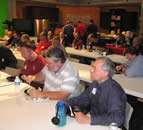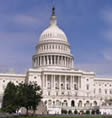Current Regulatory and Legislative Issues
Positions and opinions of the Society of Broadcast Engineers are posted here on regulatory and legislative issues that affect our members.
2 GHz UPDATE
August 23, 2013
By Chris Imlay, SBE General Counsel
For those SBE members whose work involves television ENG, you need to read this, right now. There are ongoing, fast-moving negotiations among SBE, NAB, the Department of Defense, and NTIA that will likely have a profound effect on broadcasters’ use of the 2 GHz BAS band in the very near future. None of the following information will be a surprise to regular readers of the SBE Signal, but recent negotiations necessitate this update. The bottom line is that it is quite possible that broadcasters will, within the next year or so, have new sharing partners in the entirety of the 2025-2110 MHz band in the form of United States government terrestrial and aeronautical mobile facilities which will during that time have been displaced from the 1755-1780 MHz band (so that band can be auctioned for mobile broadband purposes).
The challenges in such sharing, however, are many and they are substantial. The first is to determine whether the types of government facilities, the density of them, the geographic distribution of them, and their technical operating parameters are fundamentally compatible with 2 GHz BAS operation. The second is to determine how the two types of uses can be coordinated through SBE’s frequency coordination program and the burden of that on SBE volunteers. The third is to determine the priority of access to the 2025-2110 MHz band as between government facilities and BAS and to determine how to avoid or resolve conflicts where real-time ENG needs conflict with critical national defense operations in the same geographic areas. Finally, fourth, it is important to assess the potential sharing arrangements in the face of future (perhaps near future) threats of reallocation of parts or the entire 2 GHz band for broadband purposes.
Background.
In the February, 2013 issue of the Signal, I noted that there was a serious proposal to auction the band 1755-1850 MHz for broadband use, and that this would displace a large number of important and diverse federal uses from that 95 megahertz of spectrum, all or most of which would have to be relocated elsewhere. The only band that was being considered for reaccommodation spectrum for those Federal users is the 2025-2110 MHz band.
In March of 2011, NTIA released a Report entitled “An Assessment of the Viability of Accommodating Wireless Broadband in the 1755-1850 MHz Band.” That band was always being looked to as a band to be auctioned for broadband purposes. The Report listed “comparable bands” (i.e. bands to which NTIA believes that government facilities now operating at 1755-1850 MHz could move if that band is repurposed for broadband use). The Report concluded that government facilities could be moved to “comparable spectrum allocations” in which federal agencies (plural) would have to have “primary regulatory status.” The Report stated that the DOD identified the 2025-2110 MHz band as its “preferred option to relocate most of its operations.” Other options, said the Report, including the potential for co-primary sharing with incumbent BAS, “should be studied further.”
NTIA’s March, 2011 Report listed all of the incumbent DOD uses of the 1755-1850 MHz band: fixed, point-to-point microwave; military tactical radio relay; air combat training systems; precision-guided munitions; tracking, telemetry and commanding; aeronautical mobile telemetry; video surveillance; unmanned aerial systems; electronic warfare testing, training and exercises; software defined radio systems; and tactical targeting networks. It is quite a list. Additionally, other agencies such as the Department of Justice and the Department of Homeland Security could have some facilities that could be moved to the 2025-2110 MHz band. The NTIA Report indicated that BAS would have to move out of the 2 GHz band, or share with the military uses that would be added to the 2 GHz band.
SBE had some discussions last year and early this year with our friends at DOD about this. DOD would of course prefer to stay right where they were. DOD had concluded that the cost of moving these sensitive government facilities out of the entirety of 1755-1850 MHz was extremely high. But, in the past few months, it has become obvious that keeping all of 1755-1850 MHz is not an option for DOD. The White House and Congress (on a bipartisan basis) are both wholeheartedly in favor of auctioning at least part of that band and FCC is making plans to do that right now. If there is one thing that both political parties can agree on in this Congress, it is that auctioning spectrum to broadband providers is a good thing, and everything else has to give way. DOD has, and is acquiring more polite protocol, cognitive radio equipment. But the only band seriously considered as replacement spectrum for DOD is and has been 2025-2110 MHz.
While all this was going on, another clear threat to the 2 GHz BAS allocation appeared, this time from CTIA, which represents the mobile broadband industry and which currently carries a lot of clout with FCC, NTIA and Congress. CTIA, in March of this year, recommended to FCC that FCC should identify 15 megahertz of contiguous spectrum for reallocation to commercial broadband use, as FCC is very soon required by statute to do. CTIA proposed that the 15 megahertz come from the 2 GHz BAS band. CTIA proposed to use the 2095-2110 MHz segment, together with the 2110-2155 MHz band, for base downlinks. These would be paired with 1695-1710 MHz and 1710-1755 MHz for mobile uplinks. The 2095-2110 MHz band, said CTIA is the “clear choice for the Commission to identify and allocate.” SBE sent a rebuttal to FCC Commissioners two days after the CTIA letter was issued, noting that the 2095-2110 MHz band would be the worst possible choice, and explained the public’s reliance on real-time ENG and event production using this band daily.
SBE told DOD and NTIA earlier this Summer that 2 GHz was stretched to the breaking point already in terms of its use for real-time ENG in many, perhaps most markets, and that there could be no way that broadcasters could share with DOD’s displaced facilities if the top 15 MHz (compromising two of the seven, 12-megahertz bandwidth channels available for ENG in all markets).
These facts set the stage for the negotiations now ongoing.
The Current Negotiations
Since those first alarming indications, SBE has met repeatedly with DOD, NAB and NTIA about this issue. What has changed for the better is that it now appears that the band that is to be auctioned for broadband may not be the entire 1755-1850 MHz band. Instead, it is likely that, pursuant to the National Broadband Plan initiative, Federal agency operations will be displaced from only1755-1780 MHz, and that DOD can remain in the 1780-1850 MHz band. DOD proposes to address the loss of that 25 megahertz of spectrum in three ways: (1) it will compress many of the facilities that used the 1755-1780 MHz band into the remaining 1780-1850 MHz band that will still be available; (2) it will move some of those facilities to other Federal government allocations such as 2200-2290 MHz; and (3) it will also move some facilities, most notably Tactical Radio Relay, Small Unmanned Aircraft Systems, and High Resolution Video systems to the 2 GHz band.
When SBE was approached by DOD with this proposal, we asked DOD for some technical sharing studies that we could use to determine the level of compatibility between these government facilities and BAS ENG at 2 GHz. DOD has done this, and has been very responsive to questions asked by both SBE and NAB technical staff. It is important to note that DOD intends to be a good sharing partner, as they have been with respect to satellite uplinks that are planned for eleven United States broadcast markets. And the spectrum allocation sharing plan that they propose going forward is similar to the satellite uplink regulatory plan: while DOD seeks a co-primary domestic allocation at 2025-2110 MHz, they also propose a footnote in the Table of Allocations stating that no government operations at 2 GHz will constrain BAS operations in the same band. In other words, they will defer to broadcast operations at 2 GHz where there is a conflict in time, frequency and geography.
How can this work? Several factors and assumptions indicate that it can. Many of the DOD activities in the continental United States take place in comparatively remote areas. In many cases, there can be sufficient geographic separation between broadcast markets and the outlying areas where ENG is conducted on the one hand, and military installations where Tactical Radio Relay, Unmanned Aircraft Systems and High Resolution Video systems might operate. In cases where geographic separation between DOD and BAS operations is insufficient to prevent interference, DOD could utilize other bands or channels, thus to avoid segments of the 2 GHz band that are in use in a given area. It could also rely on listen-before-transmit protocols in order to utilize the time domain to maximize efficiency of spectrum use. In large markets where all of 2 GHz is used virtually all of the time, the DOD operations would have to be actively coordinated, or else they would use 1780-1850 MHz or another Federal government allocation such as 2200-2290 MHz. The important factor here is that DOD is apparently willing to agree to a regulatory limitation on its operations in this band that states that Federal fixed and mobile operations will not constrain BAS operation in the 2 GHz band and that BAS will not suffer harmful interference. In the context of ENG operations, harmful interference is that which would repeatedly disrupt video and audio feeds. The proposal from DOD is that Federal operations would be in a position to suffer whatever interference
Notwithstanding good faith on everyone’s part, the sharing environment in 2 GHz is challenging, and in some respects overwhelmingly so. It is unclear at this point what additional agencies might need access to 2 GHz other than DOD. Geographic separation to avoid interference is on the order of 250 km for terrestrial DOD operations. It could be far more for unmanned aeronautical operations, where altitude might approach 2000 feet, and for video feeds from helicopters and fixed wing aircraft. These uses make the DOD interference contours very large indeed. One thing is certain: BAS and DOD sharing without coordination procedures does not seem viable at all.
Why should broadcasters want to cooperate in exploring this sharing plan, since the reallocation of the 1755-1780 MHz band has nothing to do with broadcasters, and the importance of unrestricted ENG to the viewing public is so high? One purely practical answer is that sharing with DOD (which has demonstrated good faith in the past in developing a sharing situation in this same band) is far preferable to being displaced from 2 GHz as the result of the reallocation of the band, or a substantial part of it, to broadband. Reallocation of all or a major part of 2 GHz is a very real threat, and one that will not disappear entirely even after implementation of BAS/DOD sharing. There is literally no chance of sharing with broadband uses, obviously. There is pressure from Congress, the FCC and the White House on every part of the radio spectrum, most especially the bands between about 225 MHz and 4 GHz. Auction revenues are everything to the Federal government now.
Another answer is that, given the pressure on FCC to move the auction along for the 1755-1780 MHz band, and given the absence of any other candidate bands for relocating displaced United States government facilities, it may be that this sharing is a fait accompli. So it is in the best interests of the broadcast service to explore all options in good faith rather than to proceed in a defensive posture.
What Will Happen Next?
Meetings are scheduled for next week among NAB, SBE and DOD to discuss sharing options and how to overcome the challenges of real time coordinated sharing. We will be analyzing the compatibility studies provided to date, and we will try to address the tough issues discussed above. There are some reporting deadlines that exist in September, and the plans at FCC to auction the 1755-1780 MHz band continue relentlessly. We will update you on the status of this issue as we go along. Stay tuned.
***
CALL TO ACTION: We urge you to inform your station management and news directors of this development and the ramifications it could have on news reporting and other programming. If you have comments or suggestions you wish to make to SBE leadership, you are welcome to send them to the chairman of the SBE Government Relations Committee, Ched Keiler at grc@sbe.org.









